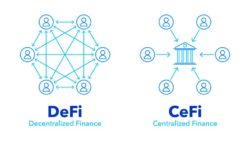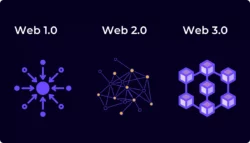Top 10 Ways Web3 Help Fight Cybercrime In The Digital Era
Web3, also known as Web 3.0 or the decentralized web, refers to the next generation of the internet that aims to revolutionize how we interact and transact online. It represents a paradigm shift from the current centralized web, where power and control are concentrated in the hands of a few large entities, to a more decentralized and user-centric model.
At its core, Web3 envisions a future where individuals have greater ownership and control over their online identities, data, and digital assets. It leverages blockchain technology, cryptography, and decentralized protocols to create a more secure, private, and censorship-resistant internet ecosystem.
One of the fundamental aspects of Web3 is the use of decentralized networks, such as blockchain, to enable peer-to-peer interactions without the need for intermediaries. These networks rely on a distributed ledger, where data is stored across multiple nodes, ensuring transparency, immutability, and resilience against censorship or single points of failure. This decentralized architecture eliminates the need for trusted third parties, enabling direct and trustless interactions between participants.
Web3 also promotes the concept of self-sovereign identity, where users have complete control over their digital identities and personal data. Instead of relying on centralized platforms to manage and store user information, Web3 empowers individuals to manage their identities using cryptographic keys and digital wallets. This not only enhances privacy and security but also enables users to have granular control over the data they share with different services or applications.
Furthermore, Web3 introduces the concept of decentralized applications (dApps), which are built on open and interoperable protocols. These applications run on the blockchain or other decentralized networks, allowing users to interact with them directly, without relying on centralized servers. dApps can range from decentralized finance (DeFi) platforms and decentralized social networks to decentralized marketplaces and governance systems.
Cryptocurrencies and digital assets are also an integral part of the Web3 ecosystem. With Web3, individuals have the ability to own and manage digital assets securely using blockchain technology. Cryptocurrencies enable frictionless and borderless peer-to-peer transactions, while non-fungible tokens (NFTs) provide a means to represent unique digital assets, such as art, collectibles, and virtual real estate, on the blockchain.
Web3 also fosters the development of decentralized governance models. By leveraging blockchain’s consensus mechanisms, stakeholders can participate in decision-making processes, vote on protocol upgrades, and influence the direction of the decentralized networks they are part of. This brings about greater transparency, inclusivity, and community-driven development.
Web3 represents a transformative vision for the internet, where users have greater control over their data, digital identities, and online interactions. It leverages decentralized networks, blockchain technology, and cryptographic principles to build a more open, secure, and user-centric internet ecosystem. Through the adoption of Web3 technologies, individuals can participate in decentralized applications, own and manage digital assets, and contribute to decentralized governance, shaping the future of the internet.
Also read: How Crypto Scams Work — A Reminder In The Age Of Digital World
Cybercrime
Cybercrime refers to criminal activities that are conducted through or targeting computer networks, systems, and devices. It involves the use of technology and the internet to commit various illegal acts, often with the intention of financial gain, causing harm, or disrupting normal operations. Cybercriminals exploit vulnerabilities in digital systems to carry out their illicit activities, posing significant threats to individuals, organizations, and even governments.
There are several different types of cybercrime, each with its own distinct characteristics and motives. Some common forms of cybercrime include:
1. Hacking: Unauthorized access to computer systems or networks with the intent of gaining control, stealing data, or causing damage.
2. Phishing: Sending fraudulent emails or creating fake websites that mimic legitimate entities to deceive individuals into revealing sensitive information like passwords, credit card details, or social security numbers.
3. Malware: The dissemination of malicious software, such as viruses, worms, ransomware, or spyware, that can infect computers, steal data, or disrupt operations.
4. Identity theft: The theft and misuse of personal information, such as social security numbers or financial details, to impersonate individuals, commit fraud, or engage in illegal activities.
5. Online scams and fraud: Various deceptive schemes conducted online, including investment fraud, romance scams, lottery scams, and fake auctions, aimed at tricking victims into providing money, personal information, or access to their financial accounts.
6. Cyberstalking and harassment: The use of technology to harass, threaten, or intimidate individuals, often through emails, social media platforms, or online forums.
7. Distributed Denial of Service (DDoS) attacks: Overloading websites or computer networks with an overwhelming amount of traffic or requests, causing them to become inaccessible to legitimate users.
8. Cyber espionage: State-sponsored or corporate-sponsored hacking attempts to gain unauthorized access to sensitive information, trade secrets, or intellectual property.
The impact of cybercrime can be severe and wide-ranging. Individuals may suffer financial losses, identity theft, emotional distress, or reputational damage. For businesses and organizations, cybercrime can result in financial loss, damage to brand reputation, disruption of operations, loss of intellectual property, and compromised customer data. Additionally, governments and critical infrastructure sectors may be targeted by cyberattacks that can have far-reaching consequences, including compromising national security.
Efforts to combat cybercrime involve a combination of technological measures, legislation, law enforcement activities, and public awareness. This includes implementing robust cybersecurity practices, such as using strong passwords, regularly updating software, and employing encryption methods. Governments and law enforcement agencies collaborate at national and international levels to investigate and prosecute cybercriminals. Furthermore, individuals and organizations are encouraged to stay informed about potential threats, exercise caution while online, and report any suspicious activities to the appropriate authorities.
Cybercrime encompasses a wide range of illegal activities conducted through or targeting computer networks and systems. It poses significant threats to individuals, businesses, and governments, and its impact can be devastating. By understanding the various types of cybercrime and taking proactive measures to protect against them, individuals and organizations can help mitigate the risks associated with this ever-evolving threat landscape.
The cost of cybercrime is a significant concern for individuals, businesses, and governments worldwide. It encompasses both direct financial losses and indirect costs associated with mitigating the damage caused by cyberattacks, strengthening security measures, and recovering from the aftermath. The financial impact of cybercrime continues to escalate as cybercriminals become more sophisticated and organizations increasingly rely on digital technologies.
Direct Costs:
1. Financial Losses: Cybercrime can result in immediate financial losses for individuals and organizations. These losses can stem from stolen funds, fraudulent transactions, unauthorized access to financial accounts, or ransom payments made to cybercriminals. Additionally, organizations may face financial liabilities due to regulatory fines or legal settlements resulting from data breaches or non-compliance with cybersecurity standards.
2. Damage to Infrastructure: Cyberattacks can cause physical damage to critical infrastructure, such as power grids, transportation systems, or industrial facilities. These incidents may require costly repairs, replacements, or downtime, leading to significant economic losses.
3. Theft of Intellectual Property: Intellectual property theft, including trade secrets, patents, or proprietary information, can result in substantial financial losses for businesses. Stolen intellectual property can be used by cybercriminals or competitors to gain an unfair advantage in the market or reproduce and sell counterfeit products.
4. Financial Fraud and Extortion: Cybercriminals engage in various forms of financial fraud, such as credit card fraud, online scams, or investment fraud. Additionally, the rise of ransomware attacks has resulted in organizations paying significant sums to regain access to their systems or sensitive data.
Indirect Costs:
1. Incident Response and Recovery: Organizations impacted by cybercrime incur costs associated with incident response, including forensic investigations, legal support, and communication efforts. Recovering from cyberattacks may involve restoring systems, rebuilding compromised networks, and implementing additional security measures to prevent future incidents.
2. Damage to Reputation: Cyberattacks can severely damage an organization’s reputation and erode customer trust. Rebuilding trust and restoring a positive brand image require significant resources, such as public relations efforts, customer notifications, and investments in improved cybersecurity practices.
3. Loss of Productivity: Downtime resulting from cyberattacks or security incidents can lead to a loss of productivity and disrupted business operations. This can impact revenue generation, customer service, and employee efficiency. Organizations may also face additional costs associated with employee training, awareness programs, or hiring specialized cybersecurity personnel.
4. Regulatory Compliance and Legal Consequences: Data breaches and cyber incidents may trigger legal obligations and regulatory compliance requirements, leading to additional costs. Organizations may face fines, penalties, or legal action for failing to protect sensitive data or comply with cybersecurity regulations.
5. Long-Term Impact: Cyberattacks can have long-lasting financial implications, especially when sensitive data is compromised. Organizations may face lawsuits, credit monitoring costs for affected individuals, and ongoing financial losses as a result of reputational damage or customer churn.
Estimating the exact cost of cybercrime is challenging due to underreporting, varying methodologies, and the dynamic nature of cyber threats. However, numerous studies and reports provide insights into the magnitude of the issue. For example, the 2021 Cost of Cybercrime Study by Accenture estimated that the average cost of cybercrime for organizations globally increased by 29% over the previous year, reaching an average of $13 million per organization.
The cost of cybercrime encompasses both direct financial losses and indirect expenses associated with mitigating cyberattacks, strengthening security measures, and recovering from the aftermath. The financial impact can be significant for individuals, businesses, and governments, underscoring the importance of robust cybersecurity measures and proactive risk management to minimize the potential costs and damages associated with cybercrime.
Challenges of fighting cyber crime
Fighting cybercrime poses numerous challenges due to the evolving nature of cyber threats, the global reach of cybercriminals, and the complex and interconnected nature of digital systems. The following are some key challenges faced in combating cybercrime:
1. Rapidly Evolving Threat Landscape: Cybercriminals constantly adapt their tactics, techniques, and procedures to exploit vulnerabilities in technology and human behavior. New types of cyberattacks and malware are continuously emerging, making it challenging for cybersecurity professionals and law enforcement agencies to keep up with the ever-changing threat landscape.
2. Global Reach and Jurisdictional Issues: Cybercriminals can operate from anywhere in the world, often taking advantage of jurisdictions that lack robust cybersecurity regulations or law enforcement capabilities. This creates challenges in identifying and apprehending perpetrators, as well as in coordinating international efforts for investigation and prosecution.
3. Anonymity and Pseudonymity: The anonymity and pseudonymity provided by the internet make it difficult to attribute cybercrimes to specific individuals or groups. Cybercriminals use various techniques, such as anonymizing tools, cryptocurrencies, or compromised systems, to hide their identities and cover their tracks, making it challenging to trace their activities back to the source.
4. Lack of Reporting and Underreporting: Many cybercrimes go unreported or are underreported due to reasons such as fear of reputational damage, concerns about legal implications, or uncertainty about where and how to report incidents. This leads to incomplete data and a limited understanding of the true extent of cybercrime, hindering effective response and prevention efforts.
5. Resource Constraints: Cybersecurity professionals and law enforcement agencies often face resource constraints in terms of personnel, expertise, and funding. The demand for skilled cybersecurity professionals surpasses the available supply, leading to skill shortages. Moreover, dedicated cybercrime units within law enforcement agencies may lack sufficient resources to investigate and respond to cyber incidents effectively.
6. Encryption and Privacy Concerns: Encryption technologies, while essential for securing data and communications, can also pose challenges in investigating cybercrimes. The use of strong encryption by cybercriminals can hinder law enforcement’s ability to access and analyze crucial evidence, leading to conflicts between privacy rights and the need for effective law enforcement measures.
7. Insider Threats: Insider threats, including disgruntled employees, contractors, or individuals with authorized access, present unique challenges. These individuals may have knowledge of internal systems and protocols, making it easier for them to exploit vulnerabilities or compromise sensitive information.
8. Lack of International Cooperation and Standards: Achieving effective international cooperation and harmonization of cybersecurity laws, regulations, and standards is a complex and ongoing challenge. Differences in legal frameworks, varying data protection regulations, and conflicting national interests can impede cooperation in investigating and prosecuting cybercriminals globally.
9. Advanced Techniques and Tools: Cybercriminals often leverage advanced techniques and tools, including artificial intelligence, machine learning, and automation, to conduct sophisticated attacks. This requires cybersecurity professionals and law enforcement agencies to constantly enhance their knowledge, skills, and capabilities to detect, prevent, and respond to these evolving threats effectively.
10. Lack of Public Awareness and Cyber Hygiene: Many individuals and organizations still lack awareness and understanding of basic cybersecurity practices, making them more susceptible to cyberattacks. Promoting cybersecurity education, training, and awareness initiatives is crucial to enhancing the overall resilience of individuals and organizations against cyber threats.
Addressing these challenges requires a comprehensive and multi-faceted approach involving collaboration between governments, law enforcement agencies, private sector entities, and international organizations. It involves initiatives such as capacity building, information sharing, public-private partnerships, legislative reforms, and international cooperation frameworks to enhance cyber threat intelligence, response capabilities, and the overall resilience of digital systems.
Also read: Top 10 Biggest Centralized Crypto Exchange Hacks In History
How Web3 can help fight cyber crime
Web3, with its decentralized and secure infrastructure, has the potential to play a significant role in fighting cybercrime. Here are several ways in which Web3 can contribute to combating cybercrime:
1. Decentralized Networks: Web3 relies on decentralized networks, such as blockchain, which offer enhanced security and resilience against cyberattacks. Unlike traditional centralized systems, where a single point of failure can lead to widespread compromise, decentralized networks distribute data across multiple nodes, making it more challenging for cybercriminals to manipulate or disrupt the system.
2. Immutable and Transparent Data: Blockchain technology, a core component of Web3, provides an immutable and transparent ledger where all transactions are recorded. This enables better traceability and accountability, making it difficult for cybercriminals to engage in fraudulent activities or cover their tracks. The immutability of blockchain data also serves as a valuable tool in forensic investigations, aiding in the identification and prosecution of cybercriminals.
3. Enhanced Data Privacy and Security: Web3 promotes the concept of self-sovereign identity and puts individuals in control of their personal data. With cryptographic principles and decentralized identity systems, Web3 enables users to manage their identities and control the data they share with online services. This reduces the risk of data breaches and identity theft, key components of many cybercrimes.
4. Smart Contracts for Secure Transactions: Smart contracts, programmable agreements that self-execute when predefined conditions are met, can help prevent fraud and enhance the security of online transactions. By leveraging blockchain technology, smart contracts eliminate the need for intermediaries and provide a secure and transparent way to conduct business, reducing the risk of payment fraud or unauthorized transactions.
5. Tokenization and Anti-Counterfeiting: Web3 enables the tokenization of digital and physical assets through non-fungible tokens (NFTs) or other token standards. This can aid in combating cybercrime related to counterfeit goods, intellectual property theft, or fraudulent transactions. By tokenizing assets on the blockchain, their provenance and authenticity can be easily verified, reducing the risk of purchasing counterfeit products or falling victim to scams.
6. Decentralized Applications (dApps): Web3 facilitates the development and deployment of decentralized applications (dApps) that operate on decentralized networks. These dApps can incorporate advanced security features, such as end-to-end encryption, multi-signature wallets, and secure communication protocols, reducing the attack surface and minimizing the risk of cyber threats.
7. Community Governance and Auditing: Web3 promotes decentralized governance models, where decisions are made collectively by the community. This can enhance security by involving multiple stakeholders in the decision-making process and ensuring transparency and accountability. Additionally, community-led auditing processes can help identify vulnerabilities or weaknesses in protocols, minimizing the risk of exploitable security flaws.
8. Crowdsourced Threat Intelligence: Web3 can leverage the power of the community to gather and share threat intelligence. By encouraging individuals to report suspicious activities, share insights, and contribute to the detection and prevention of cybercrime, Web3 can create a collaborative and proactive approach to combating cyber threats.
9. Enhanced Cybersecurity Collaboration: Web3 fosters collaboration between various stakeholders, including developers, researchers, cybersecurity professionals, and law enforcement agencies. Through open-source development, bug bounty programs, and public-private partnerships, Web3 encourages collective efforts to identify and address vulnerabilities, share best practices, and develop robust security standards.
While Web3 offers significant advantages in fighting cybercrime, it is not immune to risks and challenges. The technology is still evolving, and new security vulnerabilities may emerge. Additionally, the decentralized nature of Web3 can also be exploited by cybercriminals, requiring continuous efforts to address emerging threats and ensure the resilience and security of the ecosystem.
In summary, Web3’s decentralized infrastructure, enhanced data privacy, secure transactions, and community-driven governance
have the potential to strengthen cybersecurity measures and help combat cybercrime. By leveraging the unique features of Web3 technologies such as blockchain, smart contracts, and decentralized applications, it is possible to create a more secure and resilient digital environment that reduces the risk of cyber threats and enables safer online interactions.
Many came to build and elevate the space by advancing it for a better place for all, but few came to steal, trick and are bent on making it an unsafe space. @NCA_UK @hmtreasury @USTreasury has sanctioned 7 individuals involved in trickbot Cybercrime. #trickbot #Web3 #SCAM pic.twitter.com/zmlwCAVv02
— jpnspy.eth🕸 (@jpnspy) February 10, 2023
The future of Web3 and cyber security
The future of Web3 holds promising prospects for cybersecurity, as it introduces new technologies and paradigms that can address existing challenges and strengthen the overall security posture of digital systems. Here are several key aspects that demonstrate the potential impact of Web3 on cybersecurity:
1. Decentralized Trust and Security: Web3, built on decentralized networks like blockchain, offers a new model for establishing trust and security. By eliminating the reliance on centralized authorities and distributing trust across a network of nodes, Web3 reduces the risk of single points of failure and enhances the resilience of digital systems against cyberattacks.
2. Self-Sovereign Identity: Web3 promotes the concept of self-sovereign identity, where individuals have full control over their personal data and can selectively share it with trusted entities. This empowers users to manage their digital identities securely and reduces the risk of identity theft and unauthorized access to personal information.
3. Immutable and Transparent Ledgers: The immutability and transparency of blockchain-based ledgers provide a powerful tool in ensuring the integrity and authenticity of data. By recording all transactions in a tamper-resistant and auditable manner, blockchain technology can help prevent data manipulation, fraud, and unauthorized modifications.
4. Enhanced Privacy and Data Protection: Web3 technologies prioritize user privacy and data protection. Techniques such as zero-knowledge proofs and homomorphic encryption enable secure data sharing and processing while preserving confidentiality. This can help mitigate privacy risks and ensure that sensitive information remains protected.
5. Smart Contract Security: As Web3 embraces smart contracts, which automate the execution of agreements, ensuring their security becomes paramount. Ongoing research and development in formal verification, code auditing, and secure coding practices are essential to identify vulnerabilities and prevent the exploitation of smart contracts by malicious actors.
6. Tokenization for Secure Transactions: Web3’s tokenization capabilities, such as non-fungible tokens (NFTs) and token standards, can enhance the security of transactions. By representing assets digitally and leveraging blockchain’s transparent and traceable nature, tokenization helps prevent counterfeiting, fraud, and unauthorized access.
7. Decentralized Threat Intelligence: Web3 can facilitate the crowdsourcing of threat intelligence, enabling the community to actively contribute to the detection, analysis, and prevention of cyber threats. By leveraging the collective knowledge and insights of individuals, Web3 can create a more proactive and collaborative approach to cybersecurity.
8. Interoperability and Standardization: The interoperability of Web3 technologies and the establishment of common standards are crucial for ensuring secure and seamless interactions across various platforms and protocols. Efforts to establish interoperability frameworks and security standards will enable better integration of Web3 technologies and enhance overall cybersecurity.
9. Quantum-Resistant Cryptography: As quantum computing advances, traditional cryptographic algorithms may become vulnerable to attacks. Web3 can play a role in developing and adopting quantum-resistant cryptographic techniques to ensure the long-term security of digital systems in the face of evolving threats.
10. Collaboration and Knowledge Sharing: Web3 fosters collaboration and knowledge sharing among stakeholders, including developers, researchers, cybersecurity professionals, and law enforcement agencies. Open-source development, bug bounty programs, and public-private partnerships can facilitate the exchange of expertise, identification of vulnerabilities, and development of robust security practices.
However, it is important to note that the future of Web3 and cybersecurity is not without challenges. The rapid pace of technological advancements, evolving threat landscapes, and the need for user education and awareness pose ongoing challenges. Furthermore, the decentralized nature of Web3 can introduce new vulnerabilities and require continuous efforts to address emerging risks effectively.
In conclusion, the future of Web3 holds great potential for strengthening cybersecurity. By leveraging decentralized networks, enhancing privacy, promoting secure transactions, and fostering collaboration, Web3 can provide a more resilient and secure digital environment. However, it requires ongoing research, development, and collaboration among stakeholders to address emerging challenges and ensure that Web3 technologies are designed and deployed with robust security measures in mind.
Also read: Building trust and destroying bureaucracy with blockchain for government
Top 10 ways Web3 can help fight cybercrime
Web3 is a new iteration of the internet that is built on blockchain technology. Blockchain is a secure and transparent way of storing data, which makes it ideal for fighting cybercrime.
Here are 10 ways that Web3 can help fight cybercrime:
- Decentralization: Web3 is decentralized, which means that there is no central authority that controls it. This makes it more difficult for cybercriminals to target, as they would need to attack multiple nodes in the network in order to take it down.
- Transparency: Blockchain is a transparent ledger, which means that all transactions are recorded on the public blockchain. This makes it easier to track down cybercriminals, as their activities will be permanently recorded on the blockchain.
- Immutability: Once data is stored on the blockchain, it cannot be tampered with. This makes it very difficult for cybercriminals to change or delete records, which can help to protect victims from fraud and other crimes.
- Security: Blockchain is a very secure technology, which makes it difficult for cybercriminals to hack into systems or steal data.
- Auditability: The blockchain is a public ledger, which means that anyone can audit it to ensure that it is secure and accurate. This can help to build trust in the system and make it less attractive to cybercriminals.
- Traceability: Blockchain can be used to track the movement of goods and services, which can help to prevent fraud and other crimes.
- Accountability: Blockchain can be used to create a system of accountability, where users are responsible for their own actions. This can help to deter cybercrime and make it easier to prosecute criminals.
- Resilience: Blockchain is a very resilient technology, which means that it can withstand attacks from cybercriminals. This makes it a valuable tool for fighting cybercrime.
- Scalability: Blockchain is a scalable technology, which means that it can be used to handle large amounts of data. This makes it ideal for fighting cybercrime, which is often data-driven.
- Innovation: Blockchain is a rapidly evolving technology, which means that new and innovative ways to fight cybercrime are constantly being developed. This makes Web3 a powerful tool for fighting cybercrime in the future.
Overall, Web3 has the potential to be a powerful tool for fighting cybercrime. By providing a more secure, transparent, and auditable platform, Web3 can help to deter cybercriminals and make it easier to prosecute them.
Stay informed with daily updates from Blockchain Magazine on Google News. Click here to follow us and mark as favorite: [Blockchain Magazine on Google News].
Get Blockchain Insights In Inbox
Stay ahead of the curve with expert analysis and market updates.
latest from tech
Disclaimer: Any post shared by a third-party agency are sponsored and Blockchain Magazine has no views on any such posts. The views and opinions expressed in this post are those of the clients and do not necessarily reflect the official policy or position of Blockchain Magazine. The information provided in this post is for informational purposes only and should not be considered as financial, investment, or professional advice. Blockchain Magazine does not endorse or promote any specific products, services, or companies mentioned in this posts. Readers are encouraged to conduct their own research and consult with a qualified professional before making any financial decisions. The featured image used is just a creative depiction of the title and it does not intend to hurt sentiments of any person or institution. If it hurts anyone sentiments, please do not hesitate to reach out to Blockchain Magazine.

 Bitcoin
Bitcoin  Ethereum
Ethereum  XRP
XRP  Tether
Tether  Solana
Solana  USDC
USDC  Dogecoin
Dogecoin  Cardano
Cardano  Lido Staked Ether
Lido Staked Ether  TRON
TRON  Chainlink
Chainlink  Wrapped Bitcoin
Wrapped Bitcoin  Wrapped stETH
Wrapped stETH  Avalanche
Avalanche  Sui
Sui  Stellar
Stellar  Hedera
Hedera  Toncoin
Toncoin  Shiba Inu
Shiba Inu  LEO Token
LEO Token  Hyperliquid
Hyperliquid  Litecoin
Litecoin  Bitget Token
Bitget Token  WETH
WETH  Polkadot
Polkadot  USDS
USDS  Bitcoin Cash
Bitcoin Cash  Ethena USDe
Ethena USDe  Wrapped eETH
Wrapped eETH  Uniswap
Uniswap  MANTRA
MANTRA  Ondo
Ondo  Pepe
Pepe  Aave
Aave  Monero
Monero  NEAR Protocol
NEAR Protocol  WhiteBIT Coin
WhiteBIT Coin  Mantle
Mantle  Official Trump
Official Trump  Aptos
Aptos  Internet Computer
Internet Computer  Dai
Dai  Ethereum Classic
Ethereum Classic  Bittensor
Bittensor  Cronos
Cronos  OKB
OKB  POL (ex-MATIC)
POL (ex-MATIC)  Gate
Gate 











